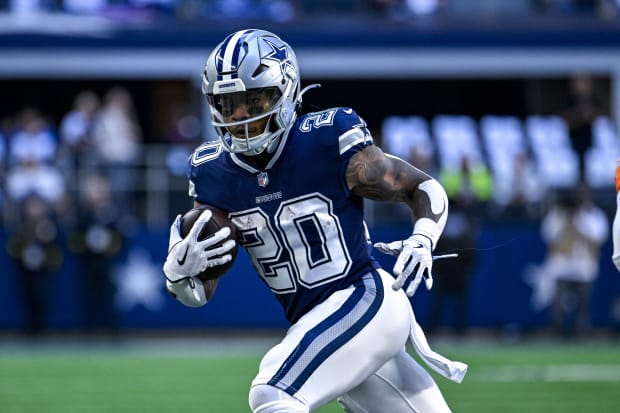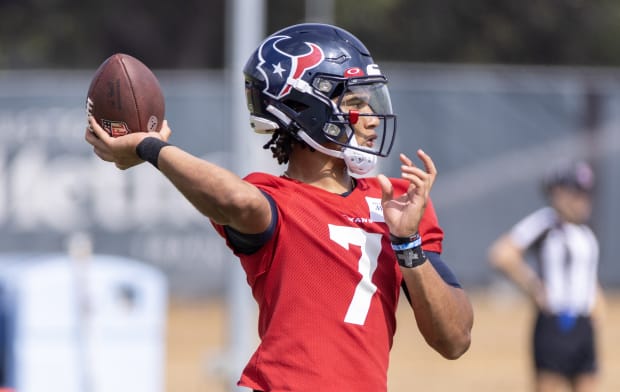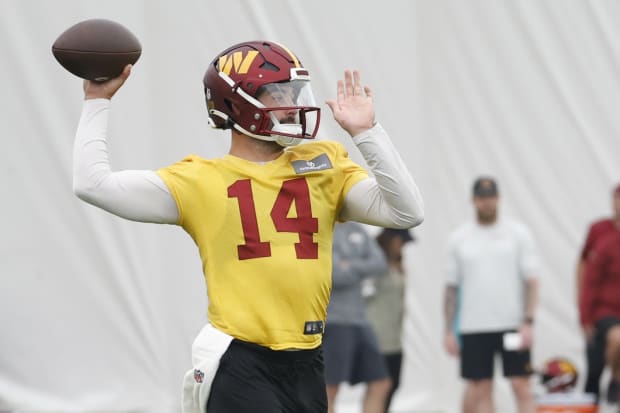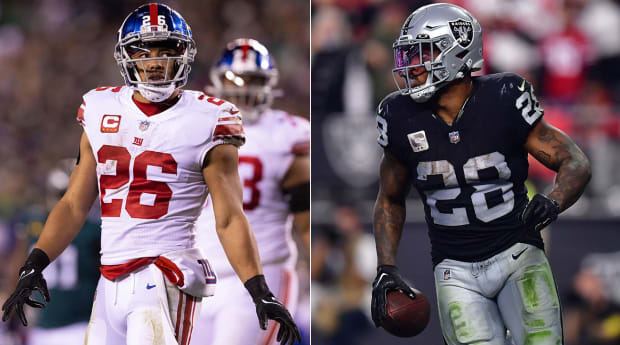The league is officially on vacation, and we have a bunch of takeaways for you this Monday morning …
Take the money, Saquon, Josh and Tony. And I’m not saying you have to do it now. But between now and July 17 (the deadline for franchise-tagged players to sign long-term deals), Saquon Barkley, Josh Jacobs and Tony Pollard should figure out just how far the Giants, Raiders and Cowboys are willing to go financially, and then clean all that money off the table.
To be clear, if you’re looking at what receivers or pass rushers or corners who play at the level those guys do, then, no, you wouldn’t be happy with what’ll be offered if you were them. But, in the end, it’s not really relevant how unfair it is.
What matters is where the market is, and how a running back’s value.
I’ve been on record saying that contracts done for guys such as Derrick Henry, Joe Mixon, Nick Chubb and even Ezekiel Elliott (where the wheels fell off at the end) were worth it for the teams. All those guys were paid significantly less than their peers at other positions, all were pivotal guys for their offenses, and each played a role in either helping to ease the development of a young quarterback, or manage the deficiencies of an average one.

Jerome Miron/USA TODAY Sports
What’s more, those guys did the right thing taking the money, because very few tailbacks get a shot at the type of life-altering second contract every player wants, and even fewer get more than one shot. Indeed, there are six guys on multi-year deals at eight figures per year, and all six of those guys signed their contracts with the team that drafted them after their third year.
Conversely, only two backs over the past decade, Shady McCoy and Le’Veon Bell, have gotten anything resembling a top-of-the-market deal after leaving the team that drafted them, and Bell actually wound up taking less than the Steelers were willing to give him the year prior.
The reality of the situation is that all the protesting in the world isn’t going to change any of this, and history hasn’t favored the back who’s gambled on himself. So, yes, Saquon, Josh and Tony, draw hard lines over the next month. Push your agent to keep pushing the team to make concessions, and sweeten your deal. But don’t do anything to jeopardize the money that you have worked so hard to earn.
This trend, by the end, isn’t only about how the NFL values running backs. It’s also, in my estimation, a result of there being fewer truly special backs—with the 230-pounders that can produce on all three downs (Barkley, Elliott, Mixon, Todd Gurley) today’s outliers.
And that, as I see it, is at least in part due to the top athletes coming into a sport matriculating to other positions. Would Odell Beckham Jr. have been Marshall Faulk in a previous generation? Could Micah Parsons have ended up the next Adrian Peterson had he grown up in the ’80s? Might Derwin James have become Eddie George if his birthdate was different? I think all those things are possible, and worth considering.
There is a way to measure it, too, in looking at recruiting rankings that list the top athletes going into the college game—because so many of those kids play multiple spots in high school, and are more or less being groomed to pick one to focus on at the next level.
Here, then, are some numbers …
• In the 2021 recruiting class, per the 247 Composite (which averages out all the recruiting services’ rankings), 15 of the top 100 players were receivers, and seven were running backs.
• In the 2022 recruiting class, 16 receivers and eight running backs were in the top 100.
• In 2023, there were 18 receivers and five backs in the top 100.
• In this coming year’s senior class, it’s 15 receivers and nine backs in the top 100.
• And if you put those four classes together, and drill down on players ranked inside the top 25, it’s 13 receivers and three backs, with it being 7–0 for the receivers in the Class of 2024.
It wasn’t that long ago that any high school powerhouse’s best athlete would be its starting tailback. That’s just not where we are anymore—and even in cases where that’s still true (Parsons was one), those athletes are often projected to other positions in college. Which, in the end, is how the Barkleys and Elliotts of the world become so far and few between.
The Chris Jones extension should get done between now and the start of camp. Kansas City has worked to keep its superstars—Patrick Mahomes, Travis Kelce and Jones—happy, and there’s no reason to believe they won’t keep that going with their havoc-wreaking defensive tackle at the end of his second contract.
His $28 million (and change) cap hit for 2023 is sitting there, and its presence means tagging the 28-year-old (he turns 29 next month) in March would cost over $33 million.
So, really, there’s no reason for Kansas City not to do a deal with a guy who’s still on the right side of 30, and had a mind-blowing 15.5 sacks as an interior lineman last year. It’ll work to lower his cap hit now, which could open another opportunity or two (maybe another look at DeAndre Hopkins?) for the team. It’ll avoid putting that massive lump sum on next year’s cap. It’ll make one of the Chiefs’ (and the NFL’s) best players happy.
All of that’s why I’d put him in a category with Nick Bosa, where it’s a question of when, not if, a deal gets done this summer. You can mark that down at, let’s say, $27 million per year or so, depending on how far Jones wants to push things.
While we’re there, there would be some benefit to Hopkins waiting until closer to training camp to sign. And the Chiefs’ situation illustrates it perfectly. Kansas City and Arizona worked on a trade to make Hopkins a Chief right before the draft. Those talks tailed off when Beckham got a deal with $15 million in base pay (with upside to $18 million), and Hopkins decided he wouldn’t take less than that.
At that point, the Chiefs were determined to add a receiver, but that didn’t mean they were going to spend for one—so they took the money earmarked for Hopkins, gave it to former Buccaneers left tackle Donovan Smith, and drafted SMU wideout Rashee Rice in the second round. And now they’ve had six good weeks with Rice in the building.
When the team gets back from vacation, they’ll go back through the roster, and debrief on the results of the spring and, at that point, it’s possible they decide they need more help at receiver, and use cap space generated through a Jones deal to get one. Or they could decide Rice filled that need. Either way, they’ll work through it, and such post-spring discussions among other teams will probably smoke out another suitor or two for Hopkins, which could move his price tag a little bit.
He could also just sign with the Patriots or Titans now—my understanding is both visits went well, and affirmed both the really solid relationship that Hopkins has with Mike Vrabel and his intrigue in the idea of playing for Bill Belichick—and be done with it.
We’ll see.

Thomas Shea/USA TODAY Sports
C.J. Stroud’s had a very nice spring in Houston. The Texans have put a pretty good lid on information over the five months that incumbent GM Nick Caserio and new coach DeMeco Ryans have been paired, but from what I’ve been able to ascertain, Stroud has shown early signs of justifying his lofty draft position.
We can get this part out of the way first—the arm talent is obvious and translated over to the practice fields in May and June.
Apart from just that, nothing’s looked too big for Stroud, which makes sense, given the stage at Ohio State; he’s shown a high aptitude and isn’t starting from zero when it comes to playing in a pro-style offense. And the coaches and front-office folks have seen other players, even the vets, gravitating toward Stroud, who’s easygoing and comfortable as a leader.
Another thing that’s helped is one specific pre-existing relationship that Stroud had in the Texans building, and that one is with his position coach, Jerrod Johnson. Johnson, who got into camp with a handful of teams as a quarterback himself, was one of Stroud’s 7-on-7 coaches over the summer of 2019 at the Elite 11 finals—and that event (Stroud threw 12 touchdown passes without a pick through the 7-on-7 tournament) is where the then-teenager’s stock as a recruit started to blow up.
The two bonded through the experience, and four years later that time has eased Stroud’s transition into the league. Add to that the knowhow of offensive coordinator Bobby Slowik and offensive assistant Shane Day, and there’s good infrastructure around the rookie, and good reason to think he’ll hit the ground running in late July.
Count the supplemental draft as another casualty of the changing landscape of college football. And I wouldn’t count that as a bad thing, necessarily.
The mid-July event has never been that big of a deal for the NFL, but some notable names have come out of it over the years. Josh Gordon and Terrelle Pryor were two such players, 11 and 12 years ago. Ahmad Brooks was another, a few years before that. And Jamal Williams, Rob Moore, Bobby Humphrey, Cris Carter, Brian Bosworth and Bernie Kosar are among the pre-2000 names on the list.
More recently, the big names were fewer and further between, but there’s always been a steady stream of guys available. From 2015-19, while only four guys were selected, a total of 25 guys (7, 6, 2, 5 and 5, by year) were eligible, with Cardinals safety Jalen Thompson the biggest name to emerge from that group.
And since then? Nothing. The supplemental drafts of 2020, ’21, and ’22 were canceled because there were no eligible prospects. This year, the draft will return. But as of right now, there’s only one entrant—Purdue receiver Milton Wright—and it’d hardly be a surprise if he wound up being the only guy selected.
Again, to me, this is a good thing. As one AFC executive put it to me on Friday night, “For most of these guys now, there will be a place to play. [The supplemental draft] was mostly for guys who were out of options. These guys have options now.”
Indeed, the free-flowing transfer portal, and loosening of a bevy of transfer rules, has allowed for guys to more easily find new options in the college game, even after being thrown off a team or deemed academically ineligible (reasons for a lot of guys in the past entering the supplemental draft). And in the cases where a guy just wants to start making money, NIL opportunities are there to keep guys in college.
To me, these are all really good developments—in that they keep guys who are longshots to make the league in school, which should, at least on paper, position them more favorably for life after football. Too often, these guys leave school, become camp fodder, get cut, and life on the other side of that probably isn’t great.
As for the one guy who is eligible this year, the big-bodied Wright was a consensus top-200 recruit coming out of high school, and broke through his third year at Purdue, with 57 catches for 732 yards and seven touchdowns in 2021, then was deemed academically ineligible for 2022. So there’s plenty to dig through for teams on a guy who probably would’ve been a Day 3 type of prospect.
The NFL is very aggressively attacking its gambling issue this summer. You’ll hear plenty more about this in the coming weeks and months—the league is rolling out an effort, in the aftermath of the spring’s player suspensions, to better educate everyone about the rules they’ve got in place. And they’re doing it amid complaints from players and agents that the rules weren’t clear ahead of those suspensions (and a few more that could come).
Bottom line, there won’t be much gray area going into the 2023 season.
As part of the effort, and according to an internal summary of the rules that’s been distributed, incoming rookies will be required to watch an additional training video that explains the importance of maintaining the integrity of the game, with a focus on two rules—to not bet on NFL games, and to not bet, period, while you’re with the team in any capacity (be it at home or on the road). For all players, in addition to already mandated training, the NFL is suggesting teams have NFL compliance for an in-person session.
On top of that, a lot of teams have their own education programs and training sessions, the full gambling policy will be included in the player manual, points of emphasis will be distributed to teams, signage will be posted at team facilities, agents will have gambling education available to them, and integrity-of-the-game clauses will be in all contracts.
And at the foundation of the effort is the idea of making the gambling rules simple for players. There are six of those …
- Don’t bet on NFL games.
- Don’t have someone else place a bet for you.
- Don’t gamble at work (team facility/stadium, road trips, team hotel, etc.)
- Don’t share inside information.
- Don’t enter a sportsbook during the NFL season.
- Don’t play daily fantasy football.
Now, there are, of course, pockmarks of hypocrisy on the league’s part here, given the hundreds of millions the NFL is raking in on sports gaming. But at least they’re being clear on all of this now, and even have set a higher bar for coaches and staff (who can’t bet on sports, period). Which should, at least in theory, help prevent the next Jameson Williams case from happening.

Geoff Burke/USA TODAY Sports
Sam Howell held serve all spring, and I believe his lead in the Washington quarterback derby is significant. Yes, Commanders coach Ron Rivera said a few weeks back that Jacoby Brissett will have a shot to win the job in the summer. But he spent the rest of the team’s offseason program telling everyone who’d listen how much he believes in Howell—and that belief was justified over the past nine weeks.
We can start with the simple stuff. For a guy whose draft status may have led to some misperception on his talent, Howell consistently put a plus arm on display in OTAs and minicamp, making throws some quarterbacks won’t, and generating plenty of velocity on the ball. Also, with the whole offense adjusting to the complex offense that new OC Eric Bieniemy is installing, Howell had his bumps, but never seemed behind in learning it.
As a result, Howell took all the first-team reps through the spring, and, again, while there were bumps, it doesn’t sound like there’s any reason for Bieniemy and Rivera to veer off that course that they set for the quarterbacks back in April.
And for what it’s worth, that offense, getting its start with Bieniemy, had a really nice nine weeks as a whole. The new coordinator has brought an urgency and attention to detail and energy to the unit, with the message clear that every player has to prove himself all over again. In particular, it’s brought the best out in third-year receiver Dyami Brown (who had a great summer as a rookie, but got hurt and has been a little lost since), and excitement over what Bieniemy will be able to do with his tight ends after coaching Travis Kelce in Kansas City.
So there’s a little optimism in D.C. ahead of a summer that will be marked by wholesale change in the organization.
The Kirk Cousins contract situation in Minnesota could be a milestone negotiation for the league. You know the landscape. Cousins did the first multi-year, fully guaranteed deal in modern NFL history in 2018, then got a second deal from the Vikings that was essentially fully guaranteed in 2020, one that would carry him through this fall.
But those old deals were done by former Minnesota GM Rick Spielman, and while the new brass loves Cousins, both personally and professionally, they’ve drawn a line in the sand this year.
More or less, they’ve made it known that they’re not guaranteeing years way out with Cousins anymore, and especially with the quarterback turning 35 in August. It isn’t that things are contentious, because talks between the team and Cousins’s camp haven’t been. It also doesn’t mean that Kwesi Adofo-Mensah and Kevin O’Connell aren’t wild about what Cousins has done for them over the past 16 months. Because the truth is they are, and my sense is a career year from Cousins in 2023 wouldn’t surprise either of those guys, or their staffs.
It’s just that, as we detailed in the column a few weeks ago, this offseason has been used by the team to reset a lot of things and clean up the team’s salary cap for a more sustainable build. And the trend in the NFL this offseason has gone away from, not toward, paying quarterbacks outside the elite tier close to what the top guys get. Derek Carr and Jimmy Garoppolo wound up doing fine, but not as well as some expected. Meanwhile, teams such as Tampa Bay, Washington and Atlanta resisted taking swings, preferring more affordable options.
So, to me, where the Cousins situation goes will be fascinating, and could help set the second-tier quarterback market going forward. If he plays his best, how far is Minnesota willing to go to keep him at age 36? If the Vikings don’t go the extra mile, will someone else?
All these questions will be relevant, and probably for more than just those involved.
I think the conversations the Bills and Stefon Diggs had last week were necessary. My understanding is that, mostly, it was he and the team needing to get on the same page on the direction of the offense. And I would say that, from my experience, Diggs is not just a really good player. Deep down, he’s a really good guy, too, which is reflected in how his teammates feel about him.
I also think that some of this probably stems from his desire to win at the highest level, and a belief that the best way for the Bills to do that is through fully leveraging his talents.
So yeah, I think he’ll be fine this year. As we detailed last week, Buffalo has to make this work in the short term, and I know the Bills are committed to doing so. After that, well, things are a little less predictable, because this isn’t the first time we’ve seen this sort of thing from a receiver—where one team inherits another’s disgruntled wideout, and, in time, the traded player winds up becoming the new team’s disgruntled wideout—and generally an issue like this won’t just go away after a flare-up is quelled.
Obviously, that’s something the Bills will have to watch for.
But in the here and now, things are O.K., and there’s a good chance the team will be able to manage it effectively through the season.



















